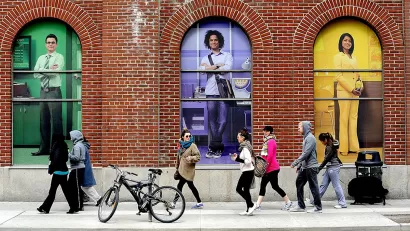The Daily Source of Urban Planning News
Room for Improvement for Citi Bike—But Not Dead Yet
Nancy Scola responds to a recent Wall Street Journal article detailing the ongoing financial troubles of Citi Bike—New York City’s bikeshare program, which is reportedly scrambling for money and operating deeply in the red.
Catastrophic Mud Slide in Washington—Could it Have Been Prevented?
The death toll in this rural area 55 miles north of Seattle in Snohomish County is expected to rise. Rain had saturated the ground and led to the collapse of a hillside about 600 feet high and 1,500 feet long. But was the slide foreseeable?
Graphic Reveals Cardinal Orientation of Street Grids
Seth Kadish says he was born with an innate sense of direction. As such, he appreciates street grids oriented to cardinal directions. The phenomena interested him enough to create a graphic that visualizes the orientation of 12 urban areas.
Tappan Zee Bridge Bike and Pedestrian Path Sparks Controversy
A recent article calls it likes it sees it: most would consider a three-mile bike and pedestrian path over the Hudson River a gift. Not so in South Nyack, at the western end of a new Tappan Zee Bridge, where such a plan sparked vehement opposition.
Commuter Taxes: An Untapped Revenue Source?
For all those cities that double population during the work day, here's a revenue thought to consider. But why restrict it to in-bound commuters? What about residents who commute-out of the city? Is the commuter tax a legitimate revenue source?
What Do Urban Trends Mean for Banks?
A recent article describes the context of urbanization around the country before examining the implications of the trend for the decisions made by bankers—i.e., where and how to invest—especially given the realities of the post-recession economy.

The Technology of Walkability
A recent article explores the promise—and potential pitfalls—of new technology to support the growing popularity of urban pedestrianism.
The Mercados Project: Lessons for the Revival of Markets
Historically, central markets served as grand social and commercial hubs for U.S. cities. A period of 20th century decline interrupted the evolution of markets, but creative and diverse examples have precipitated a recovery around the country.
25 Years after the Exxon Valdez Oil Spill, Another Major Spill Occurs
A barge spilled 168,000 gallons of heavy oil after colliding with a ship in Galveston Bay outside of Texas City on March 22, just two days shy of the 25th anniversary of the Exxon Valdez, 11 million gallon oil spill in Prince William Sound, Alaska.

BLOG POST
Transit Ridership—Debunking the Debunkers (Sort Of)
In response to the news that transit ridership reached an all-time high in 2013, commentators of all stripes sought to deny or minimize the news. But such arguments are themselves flawed.
How Utilities Fail to Predict the Economic Effects of Environmental Regulation
A familiar refrain: the EPA proposes new regulation of energy production, and the utility industry responds that new requirements will increase costs. The Center for American Progress recently looked back at how clairvoyant those claims proved to be.
Rewarded for Doing Good: Shigeru Ban Wins Pritzker Prize
The 2014 Pritzker Architecture Prize had been awarded to Shigeru Ban. Ban is best known for his innovative use of paper as a construction material and for relief work in disaster areas.

Hyper-Urbanization: China Plans for 100 Million New City Residents by 2020
China recently announced ambitious plans to move 100 million former farmers to urban environments—enough to bring the country's urban population to 60 percent of its total.
Report: New Techniques and Technology for Monitoring Active Transportation
The growing popularity of active transportation requires planners and advocates to better survey how, where, and when people are biking and walking. A new study by the Transportation Research Board shares the cutting edge of survey techniques.
More Criticism of Transit Record Claims
A pair of articles pushes back on a recent study that claims public transit use in the United States is reaching record levels.
Amid Downtown Resurgence, Columbus, OH Extends Property Tax Break
In 2013, the city of Columbus left $8.3 million in property taxes on the table as part of a tax break intended to increase the number of people living downtown. How did it respond? By extending the tax break.
New Development Begs the Question: Which Way, San Jose?
Despite its mostly sprawling conditions, San Jose has recently prioritized walkable, dense urban environments. But should the city focus its development downtown or build a connected network of urban neighborhoods?
Are Environmentalists Digging Their Own Fracking Hole in Opposing Natural Gas Exports?
In a pair of articles, The Hill's energy and environment blogger Timothy Cara looks at political efforts to increase natural gas exports to Europe on account of Russia's annexation of Crimea, part of Ukraine, and environmental groups opposed to it.
Wheels Up for Chicago’s Navy Pier Flyover
Chicago recently began construction on the $60 million Navy Pier Flyover—an elevated bike and pedestrian path built along Lake Michigan near the Navy Pier.
Virginia Expanding its High-Occupancy Toll Lanes
Despite installing many innovative traffic management schemes over the years, the 41 miles of highway between Fredericksburg, Virginia and Washington D.C. are snarled by some of the worst traffic in the country. Can HOT lanes change that?
Pagination
Municipality of Princeton
Roanoke Valley-Alleghany Regional Commission
City of Mt Shasta
City of Camden Redevelopment Agency
City of Astoria
Transportation Research & Education Center (TREC) at Portland State University
US High Speed Rail Association
City of Camden Redevelopment Agency
Municipality of Princeton (NJ)
Urban Design for Planners 1: Software Tools
This six-course series explores essential urban design concepts using open source software and equips planners with the tools they need to participate fully in the urban design process.
Planning for Universal Design
Learn the tools for implementing Universal Design in planning regulations.


































